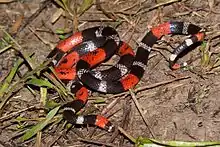Micrurus lemniscatus
Micrurus lemniscatus, commonly known as the South American coral snake, is a species of venomous snake in the family Elapidae. The species is endemic to South America.[1]
| Micrurus lemniscatus | |
|---|---|
 | |
 | |
| Scientific classification | |
| Kingdom: | Animalia |
| Phylum: | Chordata |
| Class: | Reptilia |
| Order: | Squamata |
| Suborder: | Serpentes |
| Family: | Elapidae |
| Genus: | Micrurus |
| Species: | M. lemniscatus |
| Binomial name | |
| Micrurus lemniscatus | |
| Synonyms[1] | |
| |
Description and Behavior
It is a thin and brightly colored species, adults measure 60-90 cm in length, the maximum previously reported was 145 cm, the front of the head is black and with a narrow white ring in front of the eyes, the eyes are small and the rest of the head is red. The body pattern consists of slightly broad red rings that are separated by 7 to 17 triads of 3 black and white rings, the tail has 2 black triads alternating with white rings.
Like many coral snakes, it is nocturnal and terrestrial, digging loose soil or litter, it is not aggressive towards humans, although it can attack to defend itself. Breeding is Oviparous, having a litter of possibly 20 eggs. Limentation is mainly related to other snakes, lizards and invertebrates.[2]
Geographic range and Habitat
M. lemniscatus is found in Argentina, northern Bolivia, Brazil, Colombia, eastern Ecuador, French Guiana, Guyana,[3] Paraguay, eastern Peru, Suriname, Trinidad, and Venezuela.[1] It is a widespread species in South America, they live in humid forests and lowland lowland forests, in open savannas and gallery forests. It is also found in lowland floodplains, deforested areas or near human habitation, in humid areas or near places with a water source, it occurs near sea level, at an altitude of 1,000 m.[2]
Venom
The venom of M. lemniscatus is a potent post- and pre-synaptic neurotoxin, which causes a potent and irreversible neuromuscular block in vertebrate.[4] Lemnitoxin, a potent myotoxic PLA2 type toxin, isolated from the venom of M. lemniscatus induces local and systemic myotoxicity after intramuscular and intravenous injection in mice, which is antigenically related to Micrurus nigrocinctus nigroxin, Notechis scutatus notexin, mulgotoxin of Pseudechis australis and textilotoxin of Pseudonaja textilis. [5]
Subspecies
There are currently four recognized subspecies, including the nominotypical subspecies:[6]
- Micrurus lemniscatus carvalhoi Roze, 1967
- Micrurus lemniscatus fronifasciatus (F. Werner, 1927)
- Micrurus lemniscatus helleri K.P. Schmidt & F.J.W. Schmidt, 1925
- Micrurus lemniscatus lemniscatus (Linnaeus, 1758)
Nota bene: A binomial authority or trinomial authority in parentheses indicates that the species or subspecies was originally described in a genus other than Micrurus.
Etymology
The subspecific names, carvahloi and helleri, are in honor of Brazilian herpetologist Antenor Leitão de Carvalho and American zoologist Edmund Heller, respectively.[7]
References
- "Micrurus lemniscatus ". The Reptile Database. www.reptile-database.org. Consulted 03 October 2014.
- https://www.acq.osd.mil/eie/afpmb/docs/lhd/venomous_animals_byspecies.pdf
- Cole CJ, Townsend CR, Reynolds RP, MacCulloch RD, Lathrop A (2013). "Amphibians and reptiles of Guyana, South America: Illustrated keys, annotated species accounts, and a biogeographic synopsis". Proceedings of the Biological Society of Washington. 125: 317–620. doi:10.2988/0006-324x-125.4.317.
- Floriano, Rafael S.; Schezaro-Ramos, Raphael; Silva, Nelson J.; Bucaretchi, Fábio; Rowan, Edward G.; Hyslop, Stephen (2019-07-01). "Neurotoxicity of Micrurus lemniscatus lemniscatus (South American coralsnake) venom in vertebrate neuromuscular preparations in vitro and neutralization by antivenom". Archives of Toxicology. 93 (7): 2065–2086. doi:10.1007/s00204-019-02476-9. ISSN 1432-0738.
- Casais-e-Silva, Luciana L.; Teixeira, Catarina F. P.; Lebrun, Ivo; Lomonte, Bruno; Alape-Girón, Alberto; Gutiérrez, José María (2016-08-22). "Lemnitoxin, the major component of Micrurus lemniscatus coral snake venom, is a myotoxic and pro-inflammatory phospholipase A2". Toxicology Letters. 257: 60–71. doi:10.1016/j.toxlet.2016.06.005. ISSN 0378-4274.
- "Micrurus lemniscatus". Integrated Taxonomic Information System. Retrieved 24 September 2011.
- Beolens, Bo; Watkins, Michael; Grayson, Michael (2011). The Eponym Dictionary of Reptiles. Baltimore: Johns Hopkins University Press. xiii + 296 pp. ISBN 978-1-4214-0135-5. (Micrurus lemniscatus carvalhoi, p. 49; M. l. helleri, p. 120).
Further reading
- Boulenger GA (1896). Catalogue of the Snakes in the British Museum (Natural History). Volume III., Containing the Colubridæ (Opisthoglyphæ and Proteroglyphæ) ... London: Trustees of the British Museum (Natural History). (Taylor and Francis, printers). xiv + 727 pp. + Plates I-XXV. (Elaps lemniscatus, p. 430).
- Freiberg M (1982). Snakes of South America. Hong Kong: T.F.H. Publications. 189 pp. ISBN 0-87666-912-7. (Micrurus lemniscatus, p. 115 + color photograph of M. l. carvalhoi on p. 187).
- Jan G, Sordelli F (1872). Iconographie générale des Ophidiens, Quarante-deuxième livraison. Paris: Baillière. Index + Plates I-VI. (Elaps lemniscatus, Plate V, figures 1 & 1*). (in French).
- Linnaeus C (1758). Systema naturæ per regna tria naturæ, secundum classes, ordines, genera, species, cum characteribus, diferentiis, synonymis, locis. Tomus I. Editio Decima, Reformata. Stockholm: L. Salvius. 824 pp. (Coluber lemniscatus, new species, p. 224). (in Latin).
- Roze JA (1996). Coral Snakes of the Americas: Biology, Identification, and Venoms. Malabar, Florida: Krieger Publishing Co. 340 pp. ISBN 978-0894648472.
| Wikimedia Commons has media related to Micrurus lemniscatus. |